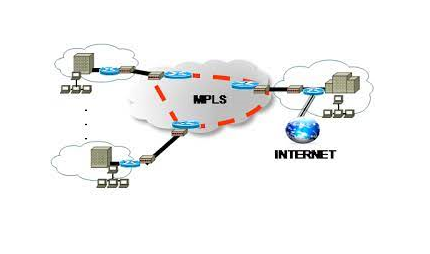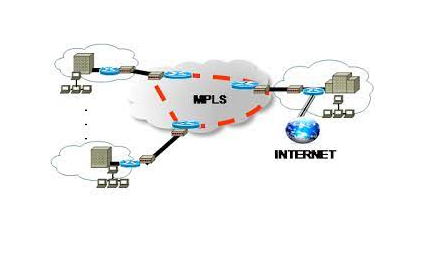What is MPLS in Networking? Everything you need to Know 2022
So, What is MPLS in Networking? Multi-protocol label modification (MPLS) is simply a data forwarding or routing technology that directs data from one intersection to the other using short path labels which therefore increases the speed and controls the network traffic flow.
With MPLS, for the first time the packet enters the network, it is assigned to the Transfer Unity (FEC), which is identified by adding short labels to the packet, an accessible WAN device introduced at the turn of the century solves this problem by creating well-designed, highly efficient routes.
Each router in the network has a table that shows how to handle packages of a specific type of FEC, so once the packet is plugged into the network, the routers do not allow for a head-to-head examination.. Instead, routers use the symbol as a list of books that give them a new FEC for that list.
This allows the MPLS network to process packets with specific components (such as from special ports or directing other types of traffic) in a consistent manner. Parks that run real-time traffic, such as voice or video, can be mapped to sub-network routes – a challenge that is commonplace.
The key architectural point of all this is that the labels provide a way to attach additional information to each packet – information above and beyond the information of MPLS network.
What is MPLS in Networking and How Does it Work

The beauty of MPLS is that it is not tied to the underlying technology. It was designed as a playback method in the days of frame and ATM playback that was designed to simplify and improve performance; That’s the “multi-protocol” part.
ATMs are a remote memory and relay framework, but MPLS resides in the backbone of transport and enterprise networks. The most common usage issues are branch offices, campus networks, Ethernet, and enterprise metro services that require quality of service (QoS) for real-time applications.
Bottom-of-Stack: Bottom-of-Stack tells MPLS Router if this is the last leg of the trip and there are no more letters to worry about.
Lifespan: Indicates how much the package can cost before it is thrown out.
Is it MPLS Layer 2 or Layer 3?
The key point of the architecture of all this is that flyers provide a way to attach additional information to each package – information beyond the previous passenger information.
Benefits and Joys MPLS
The advantages of MPLS are efficiency, performance, efficient bandwidth usage, network density, and improved user experience.
MPLS itself does not provide encryption but is a private network, so it is separated from social networks. Therefore, MPLS is considered a safe mode of transportation.
MPLS is really great to use, it can provide high internet speed which is necessary for downloading HD videos from YouTube, it can even make browsing on social media sites such as Facebook Touch.
It is also not at risk of resisting service attacks, which could affect clean IP-based networks.
On the negative side, MPLS is a service that needs to be purchased from a device and is much more expensive than posting public network traffic.
As companies expand into new markets, it may be difficult to find an MPLS service to offer global reach. The service often integrates services around the world through partnerships with other service providers, which can be costly.
MPLS was designed at a time when branch offices were moving to headquarters or data centers, but not for today’s world where branch office employees need direct access to the cloud.
Is MPLS dead?
Garter raised that provocative question back in 2013 and answered it by predicting that MPLS would continue to be an important part of the WAN landscape, but most businesses are slowing down. Simply go in a hybrid environment where there is an MPLS network and broad internet.
MPLS will continue to be a contributor to the communication of ideas in this area, such as regional headquarters, retail outlets, regional manufacturing facilities, and a wide range of information centers. And it’s important for on-time applications.
But WAN architects have to take a risk/reward planning struggle between high-notch but expensive MPLS performance vs cheap but unreliable internet performance.
MPLS vs SD-WAN
If you listen to the hype, a cheap, flexible SD-WAN is going to destroy MPLS, the slow-footed dinosaur. But, of course, both technologies have a place in today’s WANS.
SD-WAN is the application of Software Interpretation Network (SDN) concepts to the WAN. This involves the use of SD-WAN peripherals that enforce rules and policies to optimize traffic.
SD-WAN is a transport-agnostic retrofit capable of any type of traffic – including MPLS. The advantage of SD-WAN is that a WAN traffic architect can sit at a prime location and easily implement policies across all WAN devices.
In contrast, MPLS requires careful preset paths to be used and once the rounds are set up, adjustments are not a point-and-click exercise.
But once the MPLS network is deployed, it delivers guaranteed performance for real-time traffic. SD-WAN can route traffic the most efficient way, but once these IP packets hit the open internet, there are no performance guarantees.
The most sensible strategy is to load as much MPLS traffic as possible on the public internet, but continue to use MPLS for time-sensitive applications, and requires assured delivery. No one wants to get caught at the crossroads when the Director’s monthly conference falls with branch office staff dropping the middle of the sentence.





Pingback: Cryptocurrency Udemy Courses For Free - 6 Highest Rated - Familiacircle